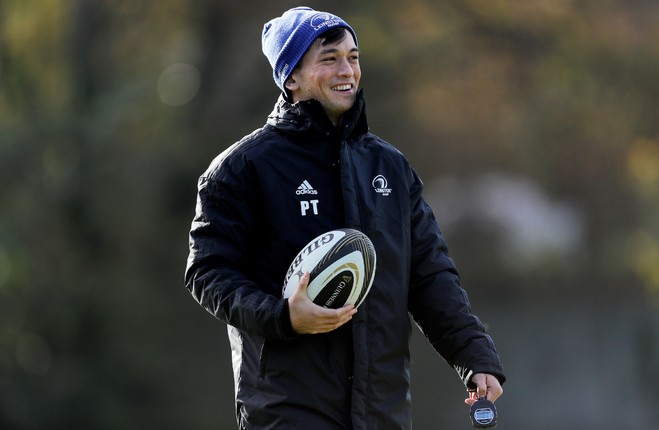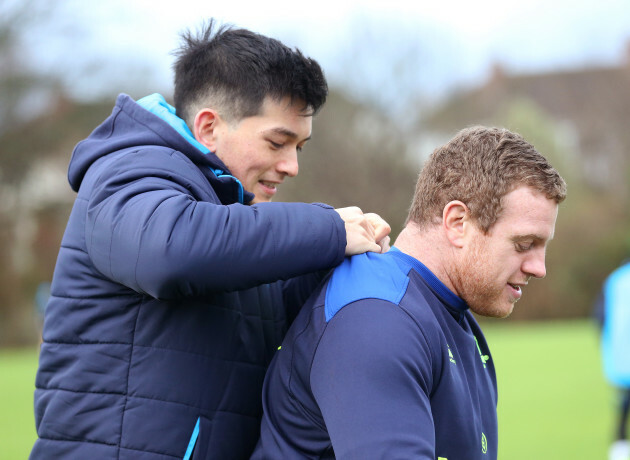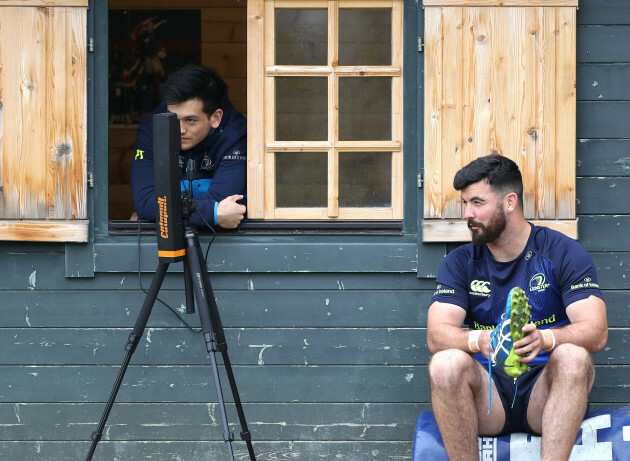SIX MONTHS INTO his new job with a high-performing sporting body, Peter Tierney hasn’t exactly got his feet under the table. More like he’s had the feet rushed from under him.
He’s constantly on the move, a perfectly fitting state considering the training style he left behind at Leinster.
The Wicklow native worked as a sports scientist in the eastern province’s backroom team from 2015 until this past summer, when he swapped one Laighin for Three Lions and took up a job with the English FA.
Tierney was at the coalface in UCD when Leinster made a noticeable shift in their playing style.
The application of Stuart Lancaster’s high-tempo, sustained pressure gameplan in training could not exist in a vacuum. The strength and conditioning staff were a key element in helping players to adapt and thrive.
For some players, the changes simply bred confidence and improved the many metrics applied to them by coaches with Ireland and Leinster. For others, the difference was also manifested externally.
In the months before what would become Ireland’s 2018 Grand Slam, Cian Healy cheerfully reported that he was fizzing around the field at about 10 kilos less than he had weighed at the 2015 World Cup. Devin Toner was also proudly speaking of improved mobility as he walked around about eight kilos under the top notch he had set on the scales.
Pack weight is a nice stat to flash up on a screen as 16 men crouch in preparation for a big set-piece shove. But there is so much more than tonnage to consider when building forwards.
“Once they get to a certain strength level where they can fulfill their roles in scrum, maul, line-out et cetera, then they need to think about the rest of the game,” Tierney tells The42 as he looks back on his time working in his native province.
“Stuart and Leo were big drivers of: everybody needs to be able to operate and play at a high intensity. They increased the pace that we were training at and also the way Leinster were playing.
“It wasn’t just a strength and conditioning thing, it was driven by coaches, players and staff. It was a shared conscious decision, ‘Okay, if we want to play this way, some people may need to lose some weight — that’s not to say everyone was trying to lose weight.”
Weight is not something to be measured in isolation, but as Tierney explains, momentum can be a revealing metic when applied to a collision sport. It should go without saying that this is not momentum in the indefinable way we so often use the word in sporting commentary – a catch-all term to denote who has the upper hand – but in the scientific sense. Mass X Velocity.
“One of the things we looked at was trying to increase momentum,” says Tierney, who has published work on the subject along with his former colleague Cillian Reardon.
“So, literally, their bodyweight multiplied by how fast they can run. So a player can put on weight as long as their momentum was increasing, (we made sure) they were maintaining their speed.
“In the same way that, if someone is trying to shed weight, we need to see the momentum go up.”
“The way we look at it is if we can increase momentum then it has a positive impact in how dominant they are when carrying and how mobile they can be around the park.”
Tierney was a player in his own right, he worked his way into Leinster U19 squads and featured in the All Ireland League for a star-studded UCD side – albeit, he admits, as the understudy hooker to Bryan Byrne – while studying in Belfield. Before he began work on the same campus with Leinster, he veered away from rugby and enjoyed a stint in competitive weightlifting.
He has certainly lifted himself out of his comfort zone since taking up the invite to interview for a sports scientist role with the FA. However, he remains indebted to the people who helped him on his way from that base, Leinster head of fitnesses past and present, Dan Tobin and Charlie Higgins, plus George Petrakos, manager of high performance at the UCD gym.
Away from collision sports, momentum metrics are no longer as important as the more general fitness standards, but preparing the best and brightest women from U17 to U21 level so that they can be ready to step into Phil Neville’s senior squad requires a constant awareness of high standards.
Tierney is primarily based in the FA’s St George’s Park in England’s midlands, but with staff needing to devote time towards projects in their day-to-day work, he rarely finds himself gathering dust in one location. The core of his workload is overseeing training camps for the elite age-grade female national teams, where he most often is the sole fitness performance coach among the football-focused staff when a given squad gather.
“It’s a nice mix of roles, it’s a diverse role and it gets me thinking about everything,” he says while looking forward to a timely Christmas break, “it’s gym training, football training, I keep an eye on nutrition and recovery as well.
“So they’re pretty busy days and weeks. But in terms of what I’d like to be doing it’s right up there as one of the most interesting roles.”
From the outside looking in, it seems like a massive change from working with heavyweight rugby players to footballing athletes where agility and mobility have always been a priority. Tierney sees just as many parallels, though.
“They’re vastly different of, course, but there are similarities as well.
“I think the girls themselves and a lot of people would be surprised at how strong they are.
“That was one of the goals of the last camp, to show them how strong and physically capable they are.”
When you drill down, high-performing teams and organisations will always have common threads and traits. England are working to ensure their successful women’s team is kept well-stocked with talent, with Tierney helping to push the next generation on.
“One of the cool things about how we’re set up is that everything we do off camp, all the projects need to be able to service all the international teams.
“That goes from U15 women to senior men. The language we use, the terms, training terminology is all really consistent across all teams.
“That’s not to say we do the same thing in every camp, but the language we use and the processes we have are at the point that, if I dropped into a different age grade camp, I should be able to operate in the camp.
“The whole idea is that, if staff have to change between squads then they can do that, but also if a player progresses from U15 all the way to senior, they’ve been brought on that journey through the same consistent language and progressions.
“It hopefully makes it easier for them to progress to the next level.”
Onwards and upwards, the perpetual motion of sport.



